June 27, 2007
CADAVRE EXQUIS CARTOGRAPHY (C.E.C.)
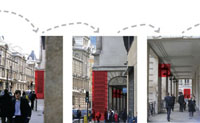
Urban Game & Mapping Exercise
FRIDAY SESSION 18 :: CADAVRE EXQUIS CARTOGRAPHY (C.E.C.); An urban game & mapping exercise followed by Talks from Dr. Maria Kaika and Julie Myers :: June 29, 2007; 6.30 pm :: Outside Bank Tube station - Take the 'Cornhill North' exit and meet us on the square outside the Royal Exchange, corner of Threadneedle St. and Cornhill :: Bring: a digital camera with its download equipment (Cables!), so we can download the images after the walk at Public Works and team-mates.
CADAVRE EXQUIS CARTOGRAPHY prompts people to explore and collect ground-level images of the City. Walks will be followed by two short talks at the public works studio at 8pm. Dr .Maria Kaika of Oxford University will talk on the continuously changing development of the City of London. Julie Myers will present - To travel Somewhere - a mobile phone / mapping project developed from a series of walks in San Francisco, USA, Cambridge, UK and Helsinki, FIN.
CADAVRE EXQUIS CARTOGRAPHY is played in pairs sharing one digital camera with display screen. Player 1 starts by taking a picture with a designated building or object in the frame as well as a second object / building of any kind. After handing over the camera to player 2, both leave the first photographed object behind, moving towards the second element of the shot. Player 2 now takes a picture with this building / object in the frame, but again with something else in the background or foreground, which will be the linking element in the next image. The camera is then handed over to player 1, who takes the next photo of the series.
THE AIM OF THE GAME IS TO COVER AS MUCH GROUND AS YOU CAN.
THE RULES:
1. A team is only allowed 30 shots and 1 camera per walk, so SHOOT CAREFULLY!
2. Images have to overlap physically and can only be of ground level building or object, so DON'T SHOOT IN THE AIR!
3. Only take images of objects/buildings in front of the team so SHOOT FORWARD!
All images will be assembled online and will allow visitors to wander through the City from behind their computer.
Maria Kaika holds a D.Phil. in Geography from the University of Oxford, and an MA in Architecture from the National Technical University of Athens as well as professional qualifications as an architect. Her previous posts include: Director of Studies in Human Geography at St Hugh's College, Oxford, Departmental Lecturer at the School of Geography, Oxford, Junior Research Fellow at Linacre College, Oxford, Lecturer in Human Geography at St Peter's College Oxford.
Dr Kaika's research focuses on urban theory, and more specifically on the politics and culture of architectural technology and design and on urban political ecology. Collaborative projects include work on: urbanism and culture; modernist urbanism and nature; urban environmental history; representations of nature and the city; governance and environmental policy; European environmental policy; theoretical approaches to sustainability; political ecology of water supply in western cities.
Julie Myers is an artist who's practice is informed by social encounter and intervention. Her work investigate memory, gesture and narrative in relation to physical environment. Sometimes recording just a brief moment captured between strangers and at other times building sustained relationship with multiple participants over a sustained period of time. She uses film/video, mobile technologies and database formats to document and present material that exists both on the web and in site specific or exhibition space.
Julie is a senor lecturer at Middlesex and Kingston Universities and lives in London. She has exhibited and screened work extensively receiving a number of awards including an AHRB research award and an Erasmus Scholarship. Previous work has been commissioned by The Arts Council of England, NESTA, The BFI, The Institute of Contemporary Art, BAA and the National Portrait Gallery. Julie has recently completed a placement at Adobe in San Francisco as part of the ACE interact program.
public works
Northgate House
2-8 Scrutton Street
UK London EC2A 4RT
Click here to view map
For more information email Jim[at]citymined.org or andreas[at]publicworksgroup.net
Posted by jo at 12:56 PM | Comments (0)
May 21, 2007
Bombay Cinema: An Archive of the City
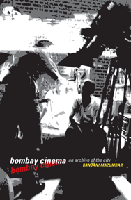
Urban Experience through the lens of Bombay Cinema
Bombay Cinema: An Archive of the City; The urban experience in India through the lens of popular Bombay cinema by Ranjani Mazumdar.
Cinema is not only a major industry in India, it is a powerful cultural force. But until now, no one has undertaken a major examination of the ways in which films made in Bombay mediate the urban experience in India. In Bombay Cinema, Ranjani Mazumdar takes a multidisciplinary approach to understanding Bombay cinema as the unofficial archive of the city in India.
In this analysis of the cinematic city, Mazumdar reveals a complex postnationalist world, convulsed by the social crisis of the 1970s and transformed by the experience of globalization in the 1990s. She argues that the upheaval of postcolonial nationalism led to Bombay cinema’s articulation of urban life in entirely new terms.
Specifically, the place of the village in the imaginary constitution of anticolonial nationalism gave way to a greater acknowledgment, even centrality, of urban space. Bombay Cinema takes the reader on an inventive journey through a cinematic city of mass crowds, violence, fashion, architectural fantasies, and subcultural identities. Moving through the world of gangsters and vamps, families and drifters, and heroes and villains, Bombay Cinema explores an urban landscape marked by industrial decline, civic crisis, working-class disenchantment, and diverse street life.
Combining the anecdotal with the theoretical, the philosophical with the political, and the textual with the historical, Bombay Cinema leads the reader into the heart of the urban labyrinth in India, revising and deepening our understanding of both the city and the cinema.
Ranjani Mazumdar is an independent filmmaker and associate professor of film studies at the School of Art and Aesthetics at Jawaharlal Nehru University, New Delhi, India.
Posted by jo at 03:21 PM | Comments (0)
April 23, 2007
205A Morning Lane
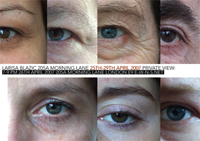
Temporary Urban Video Interventions, Architecture + Art
205A Morning Lane is a site-specific video installation using a building as a projection screen to explore possibilities of temporary urban video interventions, architecture and art. It marks the end of 205A Morning Lane studio building with two sets of visuals projected to the building's windows. First floor projection of 205A Morning Lane artists' eyes closing and second floor projection of artists' eyes opening - as eyes, window to the soul q the metaphor for cycles - endings and beginnings.
10 Video projectors are distributed in 10 artists' studios (5 on the first floor and 5 on the second) and projecting directly onto windows from inside - out thus creating two stripes of projections on the main facade. The projected material is changed on a nightly basis (five consecutive nights of projections) to play slower and slower motion so that at the end of projection all eyes close.
25TH - 29TH APRIL 2007 :: [PRIVATE VIEW: 26TH APRIL 2007 7-9PM] :: Morning Lane Studios :: 205A Morning Lane, London, E9 6LG. To get there: Hackney Central BR or busses 30, 48, 55, 106, 254; Map.
Posted by jo at 02:12 PM | Comments (0)
April 18, 2007
AreYouHere?
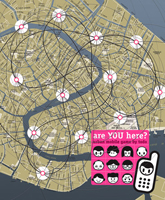
Venice - Urban Mobile Game
AreYouHere? :: 2007 - June 6th/15th - Venice - urban mobile game :: AreYouHere? is one of the 12 urban interventions of Migration Addicts, 52nd International Art Exhibition, La Biennale di Venezia, Collateral events :: Site: the whole city - starting point at Chiostro Ex Chiesa Santi Cosma e Damiano, Giudecca, 620.
AreYouHere? is an urban mobile game that aims to explore Venice through its inhabitants/migrants. More and more Venetians are leaving the lagoon to settle in other towns. In the next 30-40 years, it is certain that Venice's population will be dramatically reduced. Bar and hotel owners now come from abroad while the town is losing its original inhabitants and becoming more and more globalized. Thousands of tourists arrive to Venice everyday. The Observer provocatively wrote that if the only destiny of the town is low cost tourism then it would be better to have Venice managed by Disneyland Corporation. A kind of paradox is happening. Venice could be everywhere, that "exotic" does not exist anymore. Labor migrants from Asia are welcoming you and serving you Italian food. You are in Venice. But are you really in Venice? What do you see? Who do you meet?
AreYouHere? is an urban exploration through the faces of the people anyone can meet during his/her stay. Faces of migrants that have become the actual inhabitants, while the player is the stranger. A touristic and personal exploration of people and their faces. Those photos will be joined together into a personal postcard. He/she will receive the postcard at home. A postcard that is actually sent by him/herself. The player will receive the postcard to his/her home: a postcard that is actually sent by him/herself.. But the places you are supposed to visit, however, are not the ones you would expect to go, the top visited.
Surely you'd never take a photo of people who lives and works in these places. But that's what you have to do: shoot photos at immigrant people who live and work in Venice, carefully following the path that has been created for you, because you are the stranger, the tourist, and they are a part of Venice instead. You should take those photos with your mobile phone and send them by MMS to the number you found on the invitation. But remember, the first photo you send must be a photo of yourself: because you are a part of the game. [via]
Posted by jo at 04:34 PM | Comments (0)
April 09, 2007
Urban Interface | Berlin (Olso)
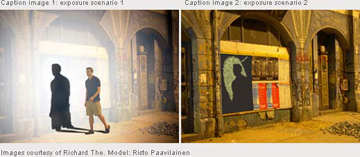
Interspaces of Public/Private Urban Space
Urban Interface Berlin :: A symposium, exhibition and curatorial research project exploring the interspaces between public and private urban space :: April 15 to May 6, 2007 :: Berlin and Oslo :: Some of the works are:
Exposure, by Jussi Ängeslevä (FI) and Richard The (DE), is a spatial art installation combining smart materials, simple sensor electronics and poster design to weave micro narratives for the unsuspecting public as they navigate through the urban landscape. An array of unobtrusive, monochromatic posters is arranged along a segment of a passageway. Adjacent to the individual posters a light gate is watching when a pedestrian passes by the poster. The light gate is connected to a tele-objective camera flash and triggers it, casting the person’s shadow momentarily on the poster. The poster, being covered with fluorescent ink, captures the shadows and retains the glowing silhouette, becoming an integrated element of the poster’s graphics which gradually fade away. The work can be seen as a commentary and counter-reaction to the established disempowerment of the individual. Above and beyond the exhausted Big Brother discourse, Exposure takes a stand also on the new emergent "Participatory Panopticon", or "Little Brother", the ever present prying eye of the neighbours’ ubiquitous camera equipped digital device.
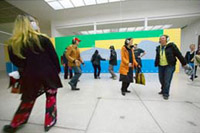
The project series Mitting operates at the interface between the sociologically and culturally different boroughs of Mitte and Wedding. For two days, the area that has been defined for the exhibition acts as a space for actions and as a starting point for mobile and stationary events. Oliver Hangl puts on two “Secret Tours” through public and private spaces that bring the coexistence of these parallel cultures to awareness. The participants, equipped with two-channel wireless headsets that enable them to choose between two alternative streams of information presented by the guides and musical liveacts, will be led through the different areas by two tour guides as well as musicians, actors, artists, DJs and a technical crew. Statements from pedestrians and local residents will flow into the liveact audio streams.
Mitting separates levels of perception while isolating the participants. On the streets, in warehouses, flats, and wherever the groups enter, they appear mute to residents and passers-by. Because of the dialogue that is sent inward through headphones, the action bears a subversive potential. But the participants should also be alert to when reality turns suddenly into fiction.
Oliver Hangl declares spaces, participants and watchers an open field of imagination, an audiovisual energy field that oscillates between performance, demo-protest and communication experiment… „Remember, that it’s all in your head!“ (Gorillaz)
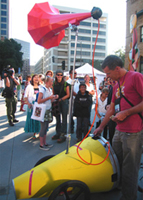
Daniel Jolliffe presents the project Berliner Stimmen in the context of urban interface | berlin. His work is a mixture of mobile sculpture and performance that examines the participatory moment. Visually, Berliner Stimmen is a sculpture mounted behind a bicycle, but its main function is performative. Over a period of three weeks, Jolliffe will cycle through the borough of Mitte, Wedding and Gesundbrunnen three times a week. While he is travelling, the loudspeaker broadcasts previously recorded one-minute calls. It is possible for each caller to have his message broadcast in the public space. The past realisations of the project under the name of One Free Minute in San José and Vancouver have shown that the callers use this public platform for different reasons. The spectrum of the recorded messages includes private statements and stories as well as commercial announcements and political speeches. In times when governments and public agencies are increasingly vigilant of who is saying what and where, citizens and activists can express their opinions in Berliner Stimmen freely and without fear of repression.
Also on exhibit: Laura Beloff's Head; Zone-out of Vision.
ABOUT urban interface | berlin
The project deals with the changing notion of private and public space that occurs due to, particularly, the everyday use of communication technologies. The artworks in the context of urban interface convey the idea of public space as an accessible and contributive sphere and call attention to a more sensitive engagement with the private, physical and digital spheres.
The works are developed for individual spaces by participating artists and if possible realised in cooperation with hosts. Hosts can be private individuals as well as companies, which then communicate the artworks out of their private spaces into the public. Private becomes public, public becomes private. Art space intermixes with urban space.
In responding to selected public and semi-public sites and their inherent qualities, the artworks will become focal points of the shifting conceptions of private and public space. Being often immaterial and digital and located at the difficult-to-define boundaries of private and public space, the artworks challenge all users – perceivers, organisers and the local authorities to formulate and discuss their individual understanding of those spaces. At the same time, the dispersed and temporary nature of the artworks challenges the formula of exhibitions in public space.
This website is conceived as an archive and contributive forum which ideally could serve as a knowledge platform for other art projects dealing with or happening in public space. To that end, relevant processes between the involved parties such as artists, sponsors, organisers and the city administration will be published on this website. Hence this website can be understood as another interface between private and public, theory and practice.
The thematic discourse is extended to presentations and panels accompanying the exhibitions
Posted by jo at 05:27 PM | Comments (0)
March 29, 2007
[iDC] Art, Lifestyle & Globalisation
![]()
"...Big Brother goes inside..."
Dew Harrison wrote:
Digital media and new technology is reconfiguring our relationship with the world and is also affecting how artists relate with their public. Now, new locative technology can position art in the everyday of people's lives and activities outside the gallery space. Although psychogeography and mobile media enable the 'interactive city' for artists to key into, they also promote ideas of corporatised play in an urban space and tend to be interventionist and intrusive. 'Big brother' media and cctv surveillance allows for few informal, ungoverned social meeting places. This means that artists are having to find interstices between the formal constructed and observed social spaces where unorthodox art can happen to engage with its audience. Just how is such practice being supported within the neo-liberal economic structures of globalistation? Julian Stallabrass suggests that this only produces artists (in Brit Art particularly) who posture as edgy, risky individuals but who are in real terms busy establishing market positions for themselves. The answer lies somewhere in the inter-related issues of art, lifestyle and globalisation.
In the 1960s Marshall McLuhan predicted a technologically enabled 'global village' and issued the warning -"Instead of tending towards a vast Alexandrian library the world has become a computer, an electronic brain, exactly as an infantile piece of science fiction. And as our senses have gone outside us, Big Brother goes inside. So, unless aware of this dynamic, we shall at once move into a phase of panic terrors, exactly befitting a small world of tribal drums, total interdependence, and superimposed co-existence."
I would be extremely interested in your thoughts on the extent to which we are 'aware of this dynamic' and offer some questions which might help probe the territory -
Corporations are rebranding themselves around lifestyle, is this influencing creative practice or vice-versa? How do the principals and aesthetics of open source and democratic media sit alongside corporate products (iPod etc)? How should arts organisations and institutions respond to open networking and ideas exchange, what is a node and a network in cultural terms? Are artists the software for the corporation hardware, or the activists in sheeps clothing? Where does government funding for the arts sit in the global cultural mix, or is corporate money driving the cultural agenda?
With thanks and kind regards,
Dew Harrison
Alan Clinton wrote:
A couple of thoughts here related to the questions you have posed. First, the rhetoric of purity (is there an outside of capitalism?) can be, I think, an endgame producing the sort of corporate artists Stallabras describes and those who are overly concerned that they may make a mistake with their art (or their theory)--no one wants to be called a hypocrite.
The problem of artists, intellectuals, and capitalism is a real one. Should I refuse to teach at the Georgia Institute of Technology because of its ties to the military industrial complex? If I had refused, when I was just out of graduate school, I would have had little opportunity to critique the system in anything resembling a full-time way--I wouldn't have had those impressionable students either. But then, if I had gone too far in my critiques, I would have been fired. Artists, it strikes me, are in a similar position. How to survive in an organism long enough to destroy or recreate it?
Rather than attempting to start from a position of purity, perhaps we should recognize that people will find themselves starting out from various positions of impurity within the system. And, there will be many ways of working against this system, of speaking to it in ways that I call, borrowing one of Derrida's metaphors, "Tympanic Politics":
"In his elucidation of marginalia as a discipline unto itself, Derrida gives a poetic anatomy of the tympanic membrane and its surroundings. The ear is swirling, labyrinthine, and cavelike. Penetrating its depths presents a difficult, frightening prospect. In addition to traversing a maze of passages, one must confront the wall of the tympanum which has the capability to muffle the loudest of noises. If normative discourse / art does not reach the inner ear with the proper sense of volume or urgency, then how is one to suggest the political or historical importance of a particular issue? For the alternative would be to shock the system in such a way as to puncture the tympanum altogether, effectively dismantling the apparatus so that nothing can be heard at all. It would be as if Constantin Brancusi, on the verge of rejecting Rodin's method of clay modeling with taille directe, had shattered The Craiova Kiss with the first hammer strike into formless stone. Derrida's answer to such questions, of course, is always a more specific anatomy of the situation at hand. He suggests that since the tympanum is oblique with respect to the ear canal, its subversion requires an oblique approach as well (taille indirecte?), some form of rhetorical ambush. How does one 'unhinge' something that cannot be shattered?"
Alan Clinton
Cecil Touchon wrote:
If artists are to engage in any dialog of a public nature such as exhibitions, publications, performances and whatnot, how shall they build enough wealth and capital to sustain their activity and carry on a home life (support a family)? Capitalism as in produce objects to be sold? The public dole? Maintain poverty? Work for a corporation?
If artists wish to engage in helping to shape the world to come, toward what are they moving in terms of a desired result?
Is it enough just to complain about, point out the problems of, or screw with the things you don’t like? Assuming the answer to be no, what else should one’s time be spent doing in order to feel that one is making a difference or helping to move the world in a better direction?
I notice that universities are training a lot of people to work for corporations and show them how to find ways to screw the general public out of small enough amounts of money to avoid calling it criminal behavior, yet we all know it is and are being screwed over regularly.
How do we train ourselves and our children to shape the world into a place we are not afraid to live in?
How do we establish and honor higher standards of living our lives so as to generate joy and peace?
What ideals should we establish among ourselves that we can all support together?
Why should we merely accept the ideals that organizations and governments and corporations want to instill in us for their benefit?
Why do we allow ourselves to be thought of as corporate consumers and properties of a state?
What would it be like if artists decided to shape a world where artists would want to live in? What would be important to them? How would they do it?
Cecil Touchon
Howard Rheingold wrote:
If people did not produce objects to be sold, we'd all be working very very hard to food, house, and transport ourselves. All too often, intellectuals who have never had to meet a payroll -- or face failure to meet a payroll -- fail to distinguish between a multinational corporation and a mom and pop store.
Howard Rheingold
Simon Biggs wrote:
Rheingold's statement is West Coast liberalism at its worst! Furry Capitalism.
In Europe and elsewhere we have lived for two generations within a rather benevolent context. If it was not for a socio-economic system where relatively generous arms length state support for the arts, and other non-industrial means of production, was default we would have seen a very different development in the arts and society since the mid 20th C.
Post Object art, performance and most media art, much of conceptual art...in fact most of what could be described as post modern practice, would not have become the dominant forms of our time. That much of the impetus for this has come from Europe is not coincidental. Such paradigms of work are only possible when value is ascribed in ways not afforded by the sort of socio-economic model on which the US is predicated and which Howard is suggesting should be default not only there but globally. One could also argue this using the example of food production. McDonalds versus artisinal food production.
I found Cecil's plaintive call for a different model both sad and uplifting. Sad that after two generations of profound social change in Europe, generally for the better, some of the same calls for change are made now as in the 1960's. Uplifting, as you do not hear enough of these sorts of calls anymore, perhaps because we have all become so cynical as a result of persistent partial failure. Perhaps we expect to much of our social systems?
My life maps almost entirely to the social democratic model. As a young artist my first professional activities were made under the fledgling but nevertheless very beneficial wing of the Australia Council (founded 1972), Australia's national agency briefed to fund the arts through peer review. The effect the Oz Council had on the creative arts in Australia was profound. Within a few years we had moved from an object based private gallery dominated model, where a handful of collectors established taste and the careers of a handful of artists, to a situation where thousands of artists were producing all sorts of crazy things (and often nothing at all) and showing this work in a diversity of artist run and non-profit spaces, or simply in the street or on the beach. It was a very creative and healthy time and in many respects resembled the joyful situation that Cecil calls for.
In the UK this sort of system was also in place from even earlier, with the Arts Council of England as a very early example of social beneficience. Other European countries, Canada, New Zealand and a number of unusual suspects, had similar models in place. Even in the US, at state level, there were similar arrangements and, for a short time, even the NEA managed to make a decent attempt at being a national arts agency run for and by artists.
The sort of model that Howard is promoting is based on a mean perception of human nature, predicated on an undertsanding that people are only motivated by their own need and where profit can only be gained at the expense of others. This is the logic of capitalism. It is also the logic of the criminal mind.
So, I read Cecil and the innocent idealism makes me cringe; but I read Howard and I get angry because what he espouses is the same ethic that amoral corporations are trying to export to the world under the moniker of Globalism. An ethic that has brought us to such a bad place in world history and now threatens the social compacts and contracts that have underpinned the relatively enlightened social models of a number of countries since the Second World War.
Rheingold articulates an anti-intellectualism that compounds his sins. Anti-intellectualism is of course a common symptom on the right of politics. I find this interesting as in this Howard is denying his own roots.
Regards
Simon
Cynthia Beth rubin wrote:
I find the use of capitalist terms to describe what we do as artists intriguing. If we go this route, we have to recognize that everything that we do as artists and intellectuals is the result of surplus capital- otherwise we would be in the fields growing corn.
In North America, we not only have surplus monetary capital, we have surplus intellectual and educational capital. We know things and think about things that are far removed from our own lives.
How do we use our surplus educational capital? And how does this play out for activist artists? Do we get to indulge in making the art that we want to make, get it recognized in galleries and through sales, and then call ourselves activists because the subject matter echoes harsh realities that are written about elsewhere?
Or are there other ways to be activists. Like volunteering to teach computer skills to adults in desperate need of a new career. Or doing page lay-outs for non-profits? It may not be an either or situation, but can we reap the benefits of the system without getting into the trenches? What really is the best way for artists to make the world a better place?
Cynthia B Rubin
Dmytri Kleiner wrote:
Cynthia Beth Rubin wrote:
> I find the use of capitalist terms to describe what we do as artists intriguing.
We have started a new group based here in Berlin called the Art & Economics Group. Let me know if you want more info.
> If we go this route, we have to recognize that everything that we do as artists and intellectuals is the result of surplus capital- otherwise we would be in the fields growing corn.
Surplus _value_. You can not eat capital.
> In North America, we not only have surplus monetary capital, we have > surplus intellectual and educational capital. We know things and think about things that are far removed from our own lives.
Education and Technical Skill that result from education are sometimes called Human Capital, however the main impact of surplus human capital within a capitalist mode of production is lower professional wages. However, this surplus human capital could also be applied toward mutual capitalizion and mutual rent capture, IMO, this is a potential basis for the method of worker's struggle I call venture communism.
> How do we use our surplus educational capital? And how does this play, out for activist artists? Do we get to indulge in making the art that we want to make, get it recognized in galleries and through sales, and then call ourselves activists because the subject matter echoes harsh realities that are written about elsewhere?
The Art & Economics group is investigating another way, the art bond. We believe that this captures the marginal value of art production untapped by mercantile or patronage based systems.
The basic idea is that we will issue bonds to fund our project, and the value of our artistic production will be measurable by comparing the demand growth, redemption rates and interest rates of our bonds to market rates.
We had our first issue in Berlin last Thursday, starting with a modest 20 2€ bonds, that earn 10% interest. We will issue more quarterly.
> Or are there other ways to be activists. Like volunteering to teach computer skills to adults in desperate need of a new career. Or doing page lay-outs for non-profits?
Both the above are good so long as the activist has some other means of support, which obviously is not the case for most.
> It may not be an either or situation, but can we reap the benefits of the system without getting into the trenches? What really is the best way for artists to make the world a better place?
Make revolution irresistible. But most importantly, avoid making capitalists richer by selling them your labour (selling them your product is ok).
(and I do mean revolution, not insurrection)
Dmytri Kleiner
Michel Bauwens wrote:
Dear Simon:
I find your contribution of the important role of state-funded very valuable.
However, I am surprised that from a short paragraph by Howard explaining why some people need to work in the market economy for a living; you deduce that he is a hardcore apologist for market only approaches. This is not the Howard that I know; and neither is the anti-intellectualist ...
What I think he is referring too is the kind of intellectual who has lived so long with public support; that he can no longer imagine that not everybody gets this support; and hence is forced to use market economy means to support his family.
Conclusion; though I believe Howard does aim to work and live from with the U.S. context, and makes various adaptations to his social situation, that is different from being a hardcore neoliberal apologist,
Michel Bauwens
Joe Rabie wrote:
Le 1 avr. 07, à 19:21, Cynthia Beth Rubin a écrit :
> I find the use of capitalist terms to describe what we do as artists intriguing. If we go this route, we have to recognize that everything that we do as artists and intellectuals is the result of surplus capital- otherwise we would be in the fields growing corn.
The relationship between art and capital is fundamental. If capitalism is all about the creation of value, then art is probably the most successful product around. One can't really imagine any product that has seen its value rise over time as much as a Van Gogh, for example (value which the original producer saw nothing of, unluckily for him).
People buy food to fill their gut, and art to symbolise their social status, or their personal power. The possession of art externalises the possession of money.
The desire of artists to be subversive in our need to portray the world is a source of unease for those who need us, whether our patrons be political or financial. We must be allowed to produce value, but our irrepressible desire to express ourselves must be kept strictly under control.
Joe
iDC -- mailing list of the Institute for Distributed Creativity iDC[at]mailman.thing.net http://mailman.thing.net/cgi-bin/mailman/listinfo/idc
List Archive:
http://mailman.thing.net/pipermail/idc/
iDC Photo Stream:
http://www.flickr.com/photos/tags/idcnetwork/
Posted by jo at 02:02 PM | Comments (0)
March 13, 2007
Digital marks
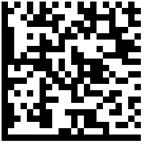
Augmented Realities
A little bit on digital marks, I selected a variety of them.
The semacode, a two dimensional code that encodes a URL. The picture (left) is the semacode of architectradure. Thank you Michael Surtees for the link! This tag embed the URL address of my blog, that can be read by your cell phone and send you to its page. I guess it avoids typing in the URL and you can rapidly go through a series of web sites using the respective tags.
It is especially useful for combining physical space to digital content. The Semacode's Software Development Kit has is developed for ubiquitous computing by creating visual tags for objects and contexts, and read them using a mobile camera phone. The physical Wikipedia called Semapedia, created by Alexis Rondeau and Stan Wiechers, allows you to add place tags on places and things to link them to the relevant Wikipedia articles.
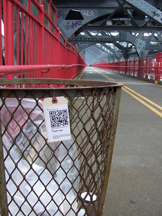 [images: trash can with a wikipedia tag] Semacode technical paper.
[images: trash can with a wikipedia tag] Semacode technical paper.
Urban Tapestries allows public mapping and sharing by combining mobile and internet technologies with geographic information systems. This system was linked to Natalie Jeremijenko's famous feral robots -open source robots for investigating contaminated urban sites- and called Robotic Feral Public Authoring: "Adding the sensor readings to online mapping tools, such as Urban Tapestries, suddenly brings the relationships between environment and home vividly to life. It enables people to feel they can learn about their environment and have the evidence to do something about it"
Yellow Arrow allows a community to tag places using arrows. You can post a message using the arrow and anyone could retrieve it using their cell phone. Another method to link digital content to a physical place. The community of yellow arrow is quite big. Their blog.
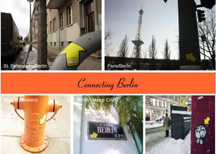
Elens allows anyone to create talking landmarks. Developed by the MIT Media Lab it allows anyone to tag a place by adding a sticker on a physical location, sticker that can later be scanned by a cell phone, in this case the Motorola A1000.
M-views developed at the MIT media lab in the interactive cinema group -media fabrics- with Glorianna Davenport, explores the "ideas, methods, and culture of mobile cinema, which is experienced in temporal and spatial narrative segments that can be delivered on context-aware mobile devices."
In 2002, I researched with Glorianna Davenport on technologies to allow digital information to communicate with the physical space. I worked on Passing Glances a system that enables users to create ambient urban interludes through the use of SMS text messages. Associated graphics and storytelling were projected in the urban space.
CHI'04 paper
Enarrative5 2003 paper
With these tags, the physical space is tagged to the digital space. One can think the other way around and tag the virtual space with physical content. That is what Josh Lifton told me he was working on the other day. Josh created a plug sensor/actuator network, called the dual reality lab, that links the MIT Media Laboratory space to a virtual lab space in the Second Life online virtual world.
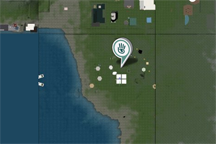
[left: Location of the MIT Media Laboratory in Second Life] More info technical about the plug. [blogged by Cati Vaucell on Architectradure]
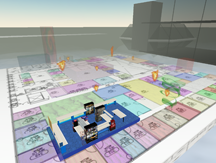
["Dual reality" is the concept of maintaining two worlds, one virtual and one real, that reflect, influence, and merge into each other by means of deeply embedded sensor/actuator networks. Both the real and virtual components of a dual reality are complete unto themselves, but are enriched by their mutual interaction. The dual reality Media Lab is an example of such a dual reality, as enabled the Plug sensor/actuator network that links our actual lab space to a virtual lab space in the Second Life online virtual world.]
Posted by jo at 01:30 PM | Comments (0)
March 06, 2007
Urban Sensorium
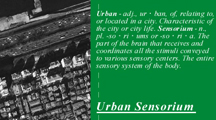
Fresh Perspectives on the Urban Mediascape
Urban Sensorium :: February 22 ~ March 25, 2007 :: TRIAD New Media Gallery, Seoul :: Participating Artists: Ji-Hoon Byun (KR), Jang-Won Lee (KR), Michelle Teran (CA), Erik Olofsen (NE), Hoax Collective (KR, GE), Jeong-Ho Park (KR), Horizon Drowner (KR). Curated by Suhjung Hur.
Urban Sensorium explores the multi-sensory experience in urban environment enhanced and intervened by media technologies. From radio, internet to emerging wireless network and pervasive surveillant system, we got immersed in the invisible layers of electro-magnetic fields, which transforms the way we perceive and experience our daily lives.
Artists in the exhibition question the notion of public space and spatio-temporal reality while viewing city as soundscape, interface for cosmos, fluid canvas and site of scopophilia. The binary between material / immaterial, city / nature, real / virtual, permanence / transience and private / public got fused into each other, contested, and redefined.
Urban Sensorium looks at not only visual but multi-sensory experience of sonic, visual, corporeal and architectural to find fresh perspectives toward urban mediascape beyond the surface of spectacles and commercial overloads.
Supported by the Arts Council Korea, Seoul Foundation for Arts and Culture, Embassy of Canada, Embassy of the Kingdom of the Netherlands and the Westin Chosun Busan.
Posted by jo at 10:45 AM | Comments (0)
February 21, 2007
Guerrilla Lighting
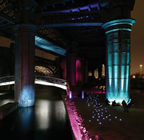
Switched ON London
Graffiti Writing to Guerrilla Lighting, yes it seems everyones a rebel these days, even the director of BDP lighting, Martin Luptn who has assembled a crack team of local lighting designers, architects, interior designers and manufacturers, all of whom are keen to draw attention to the possibilities, and importance of, lighting in the urban environment.
Under the guidance of a team leader, each member will take part in creating transient lighting designs by using high powered torches, battery powered LED projectors, luminous dot lights and an array of gels and filters. Instructed to be in a specific position and at a given distance from their target, the teams will simultaneously light up various aspects of the Pool of London’s architecture on cue at the sound of an air horn, creating a dramatic spectacle. The installation will photographed, the lighting turned off and then the team move on to the next site. It has been organised as part of Switched ON London which is a seven night celebration of the relationship between light, architecture and the city consisting of temporary lighting installations and a series of light related events with an overall concept theme of ‘theatre’. London’s first festival of light is currently running from the 8th to the 16th February. More details on the other installations to come… [blogged by Ruairi on Interactive Architecture dot Org] Related >>
Posted by jo at 02:15 PM | Comments (0)
February 16, 2007
Cities as Billboards
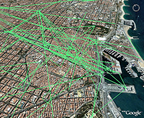
Urban Spam in "Unsold" Space
The train of thought that I started as I discussed Fabien Girardin's Flickr heatmaps a few posts back, and which led me to thinking about mining consumer line-of sight data to target advertising, seems to be continuing here in a recent New York Times article about how advertisers are now looking to use what they would consider "unsold" space to place their messages. This phenomenon even has a name, urban spam.
But why just post the same ad for everyone to see? Why not use an individual viewer's line of sight as they travel as a "channel" into which to project ads and messages where blank space exists? Fabien's recent post, illustrated here, shows the "traces" left by Flickr photographers as they transit Barcelona. Where his heat maps showed the locations of single images, the traces follow the path the photographer takes through the city, or his visual corridor, if you will. [blogged on Smartspace]
Posted by jo at 09:48 AM | Comments (0)
January 19, 2007
Sleepwalkers

a vast outdoor multiplex
In what could be the most-seen show in MoMA's history, Doug Aitken's "Sleepwalkers" opened last night on the coldest night of the year in NYC so far this season. Sleepwalkers is a nighttime installation comprised of continuous sequences of film scenes projected onto facades that transform West 53rd and 54th streets into a vast outdoor multiplex. Turning MoMA inside-out by bringing public art to the exterior walls of the new iconic building for the first time, the project is a joint effort between MoMA and non-profit Creative Time, famous for enlivening the city with public art. It was challenging to be outside to watch the premiere, but it was well worth it.
Filmed in New York, five interweaving vignettes follow each character—a bicycle messenger (played by Ryan Donowho, a drummer that Aitkin found in the subway, who's now appeared on "The O.C."), an electrician who fixes neon signs in Times Square (Seu Jorge of Life Aquatic and City of God fame), a postal worker (Chan Marshall aka Cat Power), a businessman (Donald Sutherland), and an office worker (Tilda Swinton)—through a night in New York. As they move from the solitude of their personal lives (waking up, drinking coffee or juice, leaving their apartments) to their workplace and unexpected encounters, the interconnected narratives emerge.
The eight gigantic projections, averaging 30’ x 60’, engage with the architecture in a way that I have never experienced before. You can see two of the projections from an adjoining street and walking towards the museum gives you a little clue of what's in store. In the sculpture garden (open to the public for free during the project) you see five projections at the same time—three characters and two ambient projections featuring landscapes including clouds and sunrises. Much of the imagery is in sync, i.e. when Ryan Donowho gets on his bike, Donald Sutherland climbs into his always waiting town car and Tilda Swinton hails a cab. A surprising treat is how other buildings and the museum itself reflect multiply the projections, immersing viewers in the cinematic experience.
Winner of the International Prize at the Venice Biennale and director of music videos for Interpol and Fatboy Slim, the artist's first large-scale public artwork in the United States challenges viewers perceptions of public space. Aitken calls the show a “silent film for the 21st century.” It will be projected every evening from 5-10 pm for 28 consecutive days, from 16 January-12 February 2007. To see more images, get more info and watch a trailer go here.
A few blocks away, Aitken created a one minute film, New Day, which will run once every hour in the middle of Times Square on the Astrovision Screen. New Day also depicts the constant flow of life that is New York. You can hear commentaries on your cell phone, by calling +01 408 794 0886
With contributions from Evan Orensten and Tim Yu. [posted by Wendy Dembo on Cool Hunting]
Posted by jo at 06:11 PM | Comments (0)
January 12, 2007
True Secrets
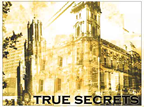
Audio Theatre on your Mobile Phone
A heads up from Diablogue informs me of a great sticker narrative project in Melbourne: True Secrets. Possibly inspired by the highly popular sticker art of Yellow Arrow, the stickers are placed in the street with a call-to-action to call a phone number. But, like the novel that is distributed via stickers around the world, Implementation, this piece provides a story.
“There are secrets in this city. True Secrets’ detectives have uncovered a treasure chest of urban tales, rumors and lost news stories. Zoom into the story and be swept back in time with these high-quality, site-specific, immersive audio dramas.”
Love to see this stuff happening more and more. For those in Sydney, and elsewhere, there are lots more Yellow Arrows locally too. But for now, check out True Secrets. [blogged by Christy Dena on Cross-Media Entertainment]
Posted by jo at 05:55 PM | Comments (0)
December 29, 2006
LAb[au]
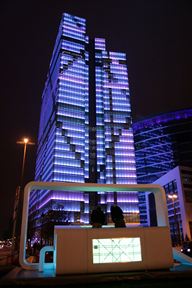
Touching the Dexia Tower
LAb[au] is happy to announce you its new urban interactive installation Touch on the Dexia Tower and Place Rogier in Brussels, Belgium. The project takes as a starting point Brussels 145 m high Dexia Tower, from which 4200 windows can be individually colour-enlightened by RGB-led bars, turning the faade into an immense display.
Instead of considering this infrastructure as a flat screen (surface) displaying pre-rendered video loops, the project is working on the architectural characteristics of the tower and its urban context. The characteristics of the building; orientation, volume, scale... are used as parameters to set up a spatial, temporal and luminous concept, which moreover allows people to directly interact with the tower.
On Place Rogier, at the bottom of the tower, a station is mounted where people can interact either individually or collectively with the tower through a multi touch screen. Both static (touch) as dynamic input (gesture) is recognized to generate an elementary graphical language of points, lines and surfaces combined with physical behaviours (growth, weight, ...) taking a monochromatic colour palette (background) combined with black and white (graphical elements).
Once a composition is created, it can be sent as an electronic postcard with a snapshot from the tower, taken from a distant location. It is also uploaded on the specific project website ( www.dexia-tower.com ) where people can retrieve their postcard, as electronic and printable format, with Christmas and New Years wishes from Brussels.
The design of the interactive station, as the project in general, is based on the idea of folding and unfolding space. This process allows the spatial design to be combined with time-based parameters, inherent to the dynamic and sequential concept of the interactive enlightening of the tower itself.
Embodied by three parts, the station is placed on Brussels North-South axis in front of the Dexia Tower. The first fold allows people to interact on a multi-touch-screen, the second fold directly displays the user interaction - finger drawing - on a projection screen. In this manner the station not only establishes a direct relation to the visual and luminous display of the tower but also shows the passers by the ongoing process of user interaction.
The interaction is constituted by both static and dynamic input, taking in account certain parameters such as width ( finger, hand, arm, .. ) , direction ( horizontal, vertical, diagonal ), duration ( introducing growth ), speed ( introducing velocity and weight ), to establish a dynamic, abstract play of graphical elements deduced from the architecture. Each of the inputs defines the colour of the background the architecture will change towards ( coordinate to colour map ), while its direction ( positive or negative ) defines the colour of the graphical element evoked ( white or black ).
The touch screen allows multiple inputs and thus allows on the one hand, people to interact with more than 1 finger, and on the other hand, to interact together, extending individual interaction to a collective experience. This real-time and collective interaction on an urban scale, transforms the Dexia Tower into a new Brussels landmark which presents art to the city.
Posted by jo at 10:28 AM | Comments (0)
December 17, 2006
SEVEN SCREENS
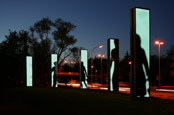
Reprojected
Reprojected – Mader/Stublic/Wiermann: A new site-specific light installation in Munich :: Until 31 March 2007.
Artificial light changes how we see cities, both in functional and, increasingly, in aesthetic terms. Its fascination for artists, designers and architects derives from the fundamental role played by light in human perception. Light can create spaces that exist independently of architectural constructions. Without light, images could not be generated, perceived or reproduced, in films, videos or anywhere else. The latest LED technology even permits images to be made from light. This approach has been adopted now in Munich by realizing the new OSRAM light platform SEVEN SCREENS which combines arts with cutting-edge technologies presented in the public space. In future, and up to twice a year, artists will be invited by OSRAM to develop works referring to the specific context.
Reprojected by Media artists Mader and Stublic, and architect Wiermann, based in Berlin / Karlsruhe, engages in a site-specific and medium-specific way with visual perception. The artists have created a virtual space around the seven light steles. Light apparently coming from elsewhere seems to strike the steles like a spotlight. For the viewer, real space and virtual space appear to co-exist, the two realms intersecting at the masts. Computer-generated figures appear in front of the light and are reproduced as silhouettes on the masts, before disappearing into the surrounding darkness.
Curator of the new OSRAM SEVEN SCREENS is art historian Christian Schoen, director of CIA.IS – Centre for Icelandic Art, Reykjavik, since 2005 and curator of the Icelandic contribution to the 2007 Venice Biennale. Schoen has headed the OSRAM GALLERY since 2001.
Holger Mader (born in Basel in 1970 and based in Berlin), Alexander Stublic (born in Saarbrücken in 1967 and based in Karlsruhe [ZKM] and Berlin) and Heike Wiermann (born in Leipzig in 1971 and based in Berlin) have acquired a national and international reputation for their dynamic multimedia installations involving light. Their best-known projects include a recent piece at the Uniqa Towers in Vienna and the video installation CUBE, currently showing at the new Museum Ritter in Waldenbuch.
Press contact
Goldmann PR, Daniela Goldmann
Bruderstrasse 5, 80538 Munich, Germany
phone +49(0)89-2111-6413, e-mail: info[at]goldmannpr.de
Posted by jo at 05:52 PM | Comments (0)
November 20, 2006
Glowlab
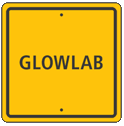
Issue 11
Welcome to Glowlab Issue 11! The projects in this issue examine the presence of surveillance within public space, and the ways in which ubiquitous technologies, such as electronic tags, global positioning systems, SMS messaging, and other locative media are informing the ways in which we interact within urban environments. These artists utilize these technologies to create mobile orchestras, jam turnstiles, observe the observers, and put the means and the media of production into the hands of ordinary citizens. This issue also includes independent curator Anuradha Vikram's review of Psychogeography by Merlin Coverly.
Transparent City: The ethics and aesthetics of mass-surveillance technologies by Derek Lomas :: Mobile phone carriers track our location and keep a record of everywhere that we have been. TRANSPARENT CITY is a prototype surveillance interface demonstrating how widespread mobile phone technology could be transformed into an apparatus for massive governmental control.
The Warbike and Wardriving: Geeks Don't Know it's Psychogeography by David McCallum :: The Warbike is a mobile, interactive artwork that sonifies WiFi networks during a bike ride. This article describes the process of creating the system, and touches on the links between psychogeography and wardriving.
Inner city locative media: The Media Portrait of the Liberties project by Valentina Nisi :: The Media Portrait of the Liberties is a modular collection of anecdotal stories drawn from a disadvantaged Dublin inner city neighbourhood called the Liberties. The narratives are displayed as short video clips on a location-aware handheld computer.
TXTual Healing by Paul Notzold :: TXTual Healing is an interactive project that enables members of the public to interact with large speech bubbles that are projected onto flat surfaces, such as the facades of public buildings, using SMS messaging.
arphield recordings by Paula Roush :: Arphield Recordings is a project documenting impromptu arphid sound performances produced by people scanning their oysters cards in their daily routines of accessing London tube stations.
Fête Mobile and Inflatable Art by Marc Tuters, Fête Mobile :: Movable Feast/ Fête Mobile is a 6-meter blimp equipped with surveillance and communications capabilities that enables participants to remotely view their surroundings and exchange media files through a wireless file server. In his article, we discuss the development of the project.
Book Review: Psychogeography by Merlin Coverley by Anuradha Vikram :: Psychogeography is a primer on the practice and its precedents, inspired by the neo-psychogeographic revival in London over the past two decades, and focusing specifically on the theoretical lineage of contemporary British writers.
Glowlab is an artist-run production and publishing lab engaging urban public space as the medium for contemporary art and technology projects. We track emerging approaches to psychogeography, the exploration of the physical and psychological landscape of cities. Our annual Conflux festival, exhibitions, events and our bi-monthly web-based magazine support a network of artists, researchers and technologists around the world.
Posted by jo at 01:40 PM | Comments (0)
November 17, 2006
Priceless
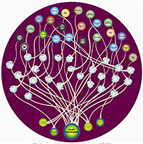
Underground Station Social Network Art
"We have created priceless, a multi-layered artwork in which the voices of individuals and institutions merge in surprising and unexpected ways. Objects of great value have been chosen by each institution to inspire an imaginative journey. People's unique stories and memories are showcased through audiovisual portraits, mobile exhibitions, installations and large-scale projections."
At London’s Huntington Station, a series of portraits and maps along the floor and walls reveal the Underground’s staff networks. The project is called Priceless. A sample of the images by motiroti is shown above.
London Underground staff have worked at the station for 138 years at the hub of a unique community of traders, museum workers, loiterers and licensed buskers who create the background atmosphere of this rich and complex environment.
motiroti has worked with LU staff to explore their personal connections and social networks. The participants were recorded in sound, video and writing by motiroti artists, who translated this information into an extraordinary series of graphic portraits and maps.
Along the length of the tunnel, 17 wall graphics and 26 individual floor constellations reveal the staff’s “hidden maps” of connections, and their personal worlds. Staff at South Kensington are connected with 66 national cities, 41 international cities, and with their friends speaking a total of 33 languages. Via Information Aesthetics [blogged by Judy Breck on Smart Mobs]
Posted by jo at 05:09 PM | Comments (0)
BlueStates:
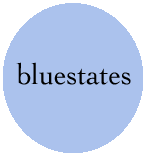
Exploring Relational Space
Cities are not merely collections of buildings; they are the living, breathing, teeming product of the human bodies who inhabit them. A city razed to the ground may recover, but a city emptied of people is dead. Yet emphasis is always given to the locative nature of a city - the neighborhood you live in, the street, the floor, the unit - an assertion of a Cartesian primacy which ignores the more profound natural relationships of the city: the coming together and parting of human beings living social lives. Cities are their people; souls are the bricks from which a city is constructed.
BlueStates: Exploring Relational Space--by Mark Pesce and John Tonkin--is an attempt to reverse the figure and ground of the city, ignoring its visible nature as a locative, Cartesian space, creating, instead, a view of the city purely as a social space. In this work, the trope of absolute location is abandoned in favor of the idea of relational proximity. BlueStates does not show you where you have been, but rather, it shows you who you have been with - a more perfect metric for the inner life of the city.

The inspiration for BlueStates is drawn from the recognition that most of us, most of the time, carry that most common of 21st century appliances, the mobile phone. Most of these mobile phones are equipped with a wireless technology known as Bluetooth. A Bluetooth mobile phone user creates a radius of electronic awareness - what we call a "bluesphere" - extending as much as ten meters from their body. When two Bluetooth devices pass in proximity to one another, each senses the other. Data is exchanged - and promptly ignored. BlueStates: Exploring Relational Space uses its own, custom software sensors - which run on mobile phones, PDAs and computers - to listen intently to the bluesphere. These sensors contribute to a database record of proximal encounters, and this data is then used to build views into the social life of the city's residents.
BlueStates is by its nature a highly participatory work. Anyone will be able to visit the website and create their own views into relational space. Residents of cities around the world will be encouraged to add their own sensors to the global network of sensors, expanding the database to incorporate the inner social life of their own cities. Beyond this, the work's creators have committed to releasing all software developed for the project as as free and open source software (under the GNU General Public License), believing this will encourage others to create their own projects in relational space. Finally, artists will be provided with tools to that will allow them to permute the data gathered by BlueStates: Exploring Relational Space in new and unique ways.
The two artists behind BlueStates have spent their careers exploring the intersection between art and technology. Mark Pesce is best known as the inventor of VRML, the standard for 3D on the World Wide Web, and has pioneered new interactive techniques for a quarter of a century. John Tonkin has consistently produced a stream of artworks that twist technology (and, occasionally, his body) into new and unexpected forms. Currently based at the University of Sydney, he has been involved in a broad range of projects including a collaboration at the Banff Centre for New Media Arts and a fellowship funded by the Australia Council. [from ISEA 06, via pasta and vinegar]
Posted by jo at 04:32 PM | Comments (0)
November 13, 2006
Saskia Sassen
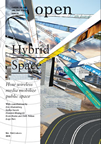
Essay and Lecture
Open 11 :: Hybrid Space: The influence of digital technologies on the use of the public domain :: Thanks to new wireless technologies (WIFI, GPS, RFID) and mobile media, public space is subject to drastic changes. It is being traversed by electronic infrastructures and networks, and alternative cultural and social domains are evolving, though often invisible from a conventional viewpoint. The traditional physical and social conditions of the public domain are being supplanted by zones, places and subcultures that transcend the local and interlink with translocal and global processes. The question is whether there are also new opportunities for the individual and for groups to act, participate and intervene publicly in this hybrid, seemingly flexible space. How do people appropriate the new public spaces? Where does the 'public' take place in this day and age? Who shapes and moulds it by devising spatial, cultural and political strategies?
With contributions by Drew Hemment, Howard Rheingold, Saskia Sassen, Frans Vogelaar/Elizabeth Sikiardi, Noortje Marres, Koen Brams/Dirk Pultau, Marion Hamm, Kristina Andersen, Ari Altena, Daniel van der Velden, Klaas Kuitenbrouwer, Esther Polak, De Geuzen and Max Bruinsma. Guest editor: Eric Kluitenberg, Jorinde Seijdel and Liesbeth Melis (eds.)
Public Interventions: The Shifting Meaning of the Urban Condition by Saskia Sassen :: De Balie, Amsterdam :: Saturday, November 18, 2006 :: Start: 20.30 hrs (CET) :: Live-stream webcast.
This year’s SKOR lecture (Fourndation for Art and Public Space) is delivered by Saskia Sassen, who will talk about the ‘making’ of public space by means of architectural and artistic interventions. The evening includes the presentation of Open 11, which takes hybrid space as its theme and includes an essay contributed by Sassen.
Human experience is threatened by the massive architecture of world cities and the density of infrastructures – digital and otherwise – that exist to serve international capital and the global economy. Sassen argues that there is a need for the production of subversive narratives as a counterbalance to this, to make the local and what has been silenced manifest and to generate new forms of ‘modest public spaces’.
Saskia Sassen is Ralph Lewis Professor of Sociology at the University of Chicago and Professor at the London School of Economics. She has gained worldwide acclaim for studies such as The Global City and Cities in a World Economy. Her most recent publication is Territory, Authority, Rights: From Medieval to Global Assemblages (Princeton University Press, 2006).
Panelists: Arnold Reijndorp, urban sociologist; Willem van Weelden, artist and theorist; Moderator: Bahram Sadeghi
Language: English
Organised by: SKOR / Open / De Balie
SKOR is the Netherlands Foundation for Art and Public Space.
Open, a cahier about art and the public domain, is published twice a year by NAi Publishers in association with skor.
ADDRESS: De Balie, Kleine Gartmanplantsoen 10, Amsterdam.
RESERVATIONS: De Balie t 020-5535100, or via >>
Admission: 12,50 (students: 7,50)
Posted by jo at 02:24 PM | Comments (0)
October 19, 2006
Net_Dérive
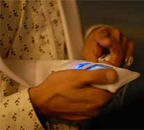
The City as Instrument
Net_Dérive, by Atau Tanaka and Petra Gemeinboeck with the collaboration of Ali Momeni, is a location sensitive mobile media art piece that calls for an exchange between participants in the gallery and participants in the streets. Deployed on advanced mobile phones, the work seeks to create a kind of musical instrument, thinking of the city-as-instrument.
Participants are given a kind of scarf with a mobile phone in each end and off they go to explore the neighborhood. One of the phones takes pictures every 20 secs and collects sounds, the other talks to the GPS (also in the scarf) and to the server inside the gallery space. On a radar they can see themselves pictured as dots but also the images they're taking. The sounds and pictures collected in the streets are sampled and mapped to a 3D city map in the gallery. As users are walking they can hear some voice instructions through a pair of headphones. Those comments suggest paths to follow or turns to make, they are generated and heard in a musical fashion. The voice instructions are inspired by the old Situationist games and theory of the Dérive - now brought into the digital and mobile spheres. As the user chooses to heed or ignore these instructions, a trace of his/her path is carved out in the city.
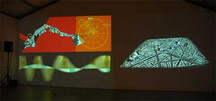
The engine then generates an audiovisual amalgam based on this information, and feeds it back as a live stream to each mobile client. The simultaneity, history, and memory of the various users’ paths and images become an abstract narrative that is summed together and projected in the gallery space. A feedback mechanism is created as users’ actions generate the collective narrative that in turn directs them.
Presented in Paris during the IntensiveScience exhibition of Sony CSL Paris, 6, 7-october 2006
Photos by Walter Kim. Images and information courtesy of Atau Tanaka.
Related: Sonic City, a wearable piece that enables people to compose music in real time by walking through the city; headphones that turn urban noise into music. Atau Tanaka's talk at Futuresonic; Pixel bondage on rice paper. [blogged by Regine on we-make-money-not-art]
Posted by jo at 08:38 AM | Comments (0)
October 10, 2006
mikroPaliskunta

Seeking Identity on the Road
mikroPaliskunta is an art project that travelled through Finland from the northest Nuorgam to the southest Hanko studying contemporary image of Finland 21.8. – 4.9.2006. Who is Finnish? What are the symbols of Finland? How has the image of Finland changed? And who defines it? The expedition travelled by a biodiesel car that was packed with five artists and protagonist of the project; a stuffed reindeer Paavo that was searching for new members to its herd.
There was a camera attached to the Paavo's horn that took pictures in one minute intervals trough the whole trip for image line seen above. Paavo also collected stories about rendevous, phenomenon and national scenerys. There are also alternative postcards that have become very popular. You can browse trough the material via the image line or the drop-down menus on the left of the page.
There were happenings during the travel in Tornio 25.8. (Aine Art Museum), in Koli 29.8. (Art Center Kolin Ryynänen) and in Imatra 31.8. (Imatra Main Library). There was material from the travel presented in these happenings and also local artists shared their perspective to the theme. You can view documentations of the happening under the theme Happenings.
Posted by michelle at 01:21 PM | Comments (0)
October 05, 2006
Media for Invisible Cities

cargo media space, belgium
Forum, online mixilogy - open project Invisible Cities.
Self Published, Weak Media traces and marks of a search for new ways of using media. Here we keep asking the question how we can make the most recent media work for us. How can we benefit from them in terms of our own development? Which capacities do we need for that? At what cost and at what expense? And what do we get in return? Can media account for applications outside their own field? Within the given technological and overtly company-dependent infrastructure, is there any possibility of criticism, experiment or creation? Or does the digital domain confiscate everything within its reach? Do media indeed bring us closer to a clearer understanding of everyday life or do they offer us a horizon by catching us in a web of age-old, endless desires?"
Posted by michelle at 06:27 PM | Comments (0)
